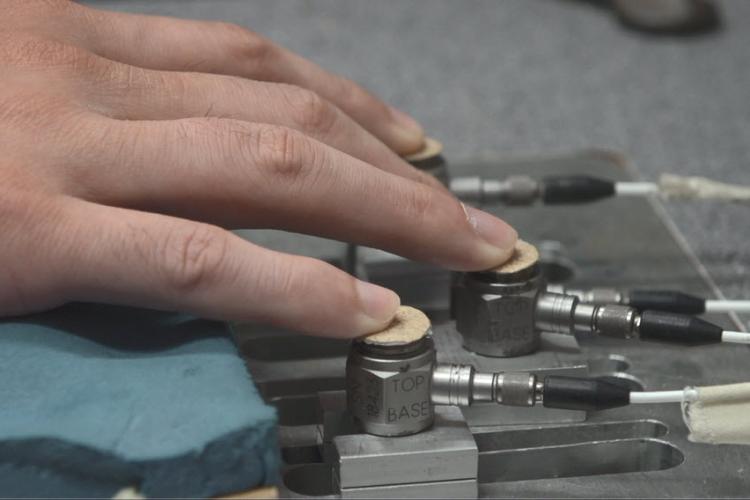Motor Control Lab

Principal Investigator: Mark Latash, distinguished professor of kinesiology
Contact: latash@psu.edu, (814) 863-5374
Location: Recreation Building 20, 21
Publications: Google Scholar
Overview
The Motor Control Laboratory (MCL) explores how the human central nervous system interacts with the the body and environment to produce purposeful, functional movements.
We search for laws of nature specific to biological movement and the physiological mechanisms that implement these laws. In addition, we explore movement stability across tasks ranging from prehension or grasping to whole-body posture and the interaction between movement production and kinesthetic perception. We also study movement disorders, their early detection, and treatment in collaboration with colleagues from the Department of Neurology.
Research in the MCL combines biomechanical and electrophysiological methods to explore a range of topics including:
-
how individual muscles, fingers, joints, extremities, and the whole-body are stabilized(using the framework of the uncontrolled manifold hypothesis);
-
intentional and unintentional actions (using the theory of control with spatial referent coordinates);
-
kinesthetic perception and perceptual errors; and
-
loss of movement stability and agility with healthy aging and neurological disorders.
History and Impact
The Motor Control Laboratory (MCL) at Penn State (MCL@PSU) was organized in 1995 by Alexander Aruin and Mark Latash and two graduate students, William Forrest and Takako Shiratori. From its birth, MCL@PSU worked in close collaboration with Vladimir Zatsiorsky of Penn State's Biomechanics Laboratory. More recently, we have been collaborating closely with Xuemei Huang of the Department of Neurology and the Translational Brain Research Center.
Three decades of the MCL
Laboratory members were instrumental in organizing the first two conferences of the series “Progress in Motor Control” (in 1996 and 1999), starting the journal “Motor Control” (Takako Shiratori, Vijaya Krishnamoorthy, and Halla Olafsdottir served as Editorial Assistants to Editor Mark Latash), and starting the International Society of Motor Control. Among other initiatives is the Annual Motor Control Summer School.
Undergraduate Research Opportunities
The Motor Control Lab welcomes interested undergraduate students who would like to get acquainted with motor control research and, possibly, participate in one of the current projects under the supervision by one of the doctoral students. For more information, contact Dr. Latash at latash@psu.edu.
Facilities
The Laboratory is equipped to perform studies of a variety of movements at different levels of analysis. There are experimental setups to explore the control of vertical posture and associated actions (e.g., step initiation), multi-finger accurate force production tasks, multi-digit prehensile tasks, multi-joint actions by an extremity, etc. In particular, we have sets of one-component and six-component force sensors, EMG systems for surface recording and identification of motor units, force plates, motion analysis systems, and unique custom-made systems such as the “inverse piano”, “suspension system”, “expanding handle”, etc. Our most recent studies involve analysis of:

individual muscle action and its stability at the level of motor units;
unintentional force drifts;
force perception and force matching;
performance stabilizing synergies at the level of control variables;
the effects of fatigue on intra-muscle and multi-muscle synergies; and
effects of Parkinson’s disease and healthy aging on all of the above.
Representative Publications
Books
Latash M.L., Zatsiorsky V.M. (2016) Biomechanics and Motor Control: Defining Central Concepts. Academic Press: New York, NY.
Latash M.L. (2019) Physics of Biological Action and Perception. Academic Press: New York, NY.
Latash M.L. (Editor) (2020) Bernstein’s Construction of Movement: Original Text and Commentaries. Routledge: Abingdon, UK.
Latash M.L., Singh T. (2023) Neurophysiological Basis of Motor Control. Third Edition. Human Kinetics: Urbana, IL.
Journal papers
Latash M.L., Huang X. (2015) Neural control of movement stability: Lessons from studies of neurological patients. Neuroscience 301: 39-48.
Latash M.L. (2021) Laws of nature that define biological action and perception. Physics of Life Reviews 36: 47-67.
Madarshahian S., Letizi J., Latash M.L. (2021) Synergic control of a single muscle: The example of flexor digitorum superficialis. Journal of Physiology 599: 1261-1279.
Latash M.L. (2021) Efference copy in kinesthetic perception: A copy of what is it? Journal of Neurophysiology 125: 1079-1094.
Madarshahian S., Ricotta J., Latash M.L. (2022) Intra-muscle synergies stabilizing reflex-mediated force changes. Neuroscience 505: 59-77.
